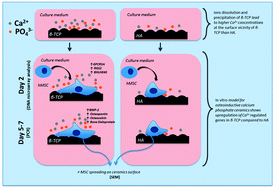Molecular mechanisms of biomaterial-driven osteogenic differentiation in human mesenchymal stromal cells†
Abstract

* Corresponding authors
a
Department of Tissue Regeneration, MIRA Institute for Biomedical Technology and Technical Medicine, University of Twente, Drienerlolaan 5, 7522 NB Enschede, The Netherlands
E-mail:
anabarradas@me.com, vemo87@gmail.com, c.b.s.s.danoux@utwente.nl, h.a.m.fernandes@utwente.nl, Z.Tahmasebi@utwente.nl, p.habibovic@utwente.nl, c.a.vanblitterswijk@tnw.utwente.nl, j.deboer@utwente.nl
Fax: +31 (0)53 489 2150
Tel: +31 (0)53 489 3400
b
Delft Bioinformatics Lab, Delft University of Technology, Mekelweg 4, 2628 CD Delft, The Netherlands
E-mail:
m.hulsman@tudelft.nl, M.J.T.Reinders@tudelft.nl
Fax: +31 (0)15 27 81843
Tel: +31 (0)15 27 86052
c
Xpand Biotechnology BV, Bilthoven, The Netherlands
E-mail:
florence.de.groot@xpand-biotech.com, huipin.yuan@xpand-biotech.com
Fax: +31 (0)30 229 7299
Tel: +31 (0)30 229 7280

 Please wait while we load your content...
Something went wrong. Try again?
Please wait while we load your content...
Something went wrong. Try again?
 Fetching data from CrossRef.
Fetching data from CrossRef.
This may take some time to load.
Loading related content
